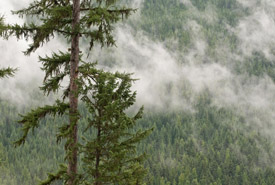NCC: Nature-based solutions: a carbon approach

Misty Darkwoods forest, BC (Photo by Bruce Kirkby)
Many Canadians have been affected either directly or indirectly by some of the more serious effects of our rapidly changing climate. While different regions across the country experience these effects differently, urban and rural residents across Canada have felt the impact of more frequent and intense rainfall events, higher temperatures and increased drought. Other examples of climate-related events include changes in ice and snow conditions, storm surges in coastal communities and forest fires.
Related content:
Across Canada and throughout the world, there is growing interest in using nature to address some of these ever-increasing threats posed by climate change and a generally warming planet. Known as nature-based solutions, these approaches involve us protecting, managing and restoring natural ecosystems in order to address and, hopefully, reduce the frequency and severity of some of these events. In fact, it is estimated that nature-based natural climate solutions may provide up to 37 per cent of the reduction in global greenhouse gas emissions necessary to keep the climate from warming less than 2 degrees Celsius by 2030. Here at the Nature Conservancy of Canada (NCC), our work already involves the implementation of nature-based approaches, solutions that are conducive to dealing with a number of these problems.
One of the most important ways of dealing with rising levels of greenhouse gas emissions, particularly carbon dioxide (CO2), is by ensuring that carbon remains stored in the soil, as well as in trees and other vegetation (such as peatlands), so that the carbon isn’t emitted in the first place. While this ensures that the problem isn’t being made worse, the protection of our forests, grasslands, peatlands and other natural ecosystems also allows CO2 to be taken out of the atmosphere, allowing additional carbon to be stored within these systems. This process is called carbon sequestration. It is vitally important to conserve these underlying natural ecosystems, which not only store existing carbon, but to also allow them to continue sequestering carbon within these ecosystems. Doing so increases carbon storage over time and is a great example of a nature-based solution.
One of Canada’s leading nature-based solutions projects has already been undertaken by NCC in the Darkwoods conservation project. Located in southeastern British Columbia, the Darkwoods Conservation Area spans more than 62,000 hectares (more than 155,000 acres) and is the site of one of North America’s largest forest carbon projects. Darkwoods is also one of Canada’s largest private land conservation projects. Not only does it provide habitat for many species of flora and fauna, it also provides carbon credits (sometimes called offsets) to organizations and companies seeking to offset greenhouse gas emissions that are unable to be fully eliminated in the short-term.
Companies like Microsoft Corporation, National Bank of Canada, Proof Inc. and many others have all supported the conservation efforts of NCC and this project through the purchase of carbon offsets over many years. NCC has held this project up against some of the world’s most stringent standards to ensure the integrity of the carbon credits, as well as the conservation value of the project itself.
This is just one example of a nature-based solution that provides tangible, positive impacts, not only for the conservation of biodiversity, but also for the climate. NCC is grateful for the support of its many donors to this important work.




